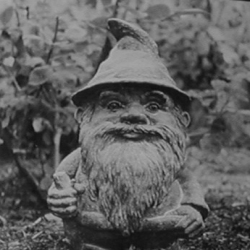Lurking In The Garden
While on holiday at your ailing grandmum's, Tanworth-in-Arden, you're instructed to go 'round the back of the house and take care of some light gardening, watering plants and the like. So far having lived close to half your life in 21st century London, you are used to a certain aesthetic: bustling, urban, cosmopolitan, stylish. A quaint few days in the country is exactly what you need to expand your worldview. What do people DO out here, anyway?
Out back, past an arched doorway you find yourself in the midst of a lush garden. Marigolds, Candytufts, Mignonette, Forget-me-nots, and Aubretia assault your senses. Two stone fountains occupy the corners along the walls. However, a further surveying of the scene reveals a horrific detail, perhaps previously blocked out unconsciously by your precocious mind; an answer to your query about just what it is that people do out here.

Apparently, they befriend and enlist the help of awful little men, allowing them to stay in the garden indefinitely. 'To what end?', you wonder.
Surveying the grotesque features of this little denizen of botanic terror, you find nothing genuinely cute, warm, inviting, or otherwise pleasant in its makeup. You are instead overtaken by a queasy daze. Tiny icy hands seem to be gripping at your feet and legs. You can't move, and yet you feel as though your safety (or sanity at least) depend on turning heel and running as fast as your 11-year old legs can carry you. Away from the garden. Away from grandmum. Away from it.
Gnomes have been part of Germanic folklore since at least the 1400s, and found their way into that of other regions. One comes away from these stories with a particular uneasiness, because a gnome's intentions are rarely known, understood or expected, and one was apparently just as likely to meet an evil gnome as a friendly gnome.
The idea of gnomes to protect one's garden ("der Gartenzwerg") seems to have been thought up by a potter from Graefenroda, a small village hidden away in the forests of Thuringia in eastern Germany, in the early 19th century. Eventually other potters and even woodcarvers in the region got into the act, spurned on by the popularity of these little creatures, as well as the steady rise of folkloric interest garnered by the stories of the Brothers Grimm of Hanau.
Kimmel claims the first recorded appearance of der Gartenzwerg in England was around 1840 at the Northamptonshire estate of Sir Charles Isham, an eccentric who inherited his mother's love of gardening, and had traveled extensively in Germany. Perhaps not surprisingly, the gnomes terrified Sir Charles' daughters, who eventually had them all removed from the estate. The most famous of the 21 gnomes imported from Nuremberg by Isham, Lampy, somehow managed to stay hidden. He has avoided capture, and is now insured for a sum exceeding 1 million UKP.

Philipp Griebel and August Heissner began producing clay garden gnomes in great quantities around 1872. Heissner gnomes are the most famous and sought-after of all master craftsman work, and during this period, the best Heissners were considered great works of art, a true part of serious art collections.

A long period of wartime production necessity in 20th century Germany caused the closing of most gnome manufacturing workshops, their spaces and labor force reappropriated to the solemn task of arming and clothing the troops. A few decades after the merciful end of World War II, plastic recreations of the famous designs of Heissner and others, began to pop up in Germany and elsewhere around Europe. Cheaper to manufacture (and thus purchase), they became a common sight in european gardens. Although ostensibly providing the same protection as those of the past, the garish colors and often shoddy construction of this new breed of gnome edged them over the line of questionable taste that they had been perilously close to since their introduction.

Today, in great part reviled and lampooned in popular culture, they are less likely to adorn the gardens of those both in europe and abroad. Only Kimmel are still considered to be a serious maker of quality clay gnomes. Tongue-in-cheek organizations such as the Garden Gnome Liberation Front feign an interest in and affection for the gnomes that was genuine in the 19th century.
A question remains about a key aspect of the garden gnome: In nearly all folkloric incarnations, the gnome is a subterranean creature, and turns to stone in sunlight. Why then, did people rely on them for protection in the open sunny spaces of their backyard gardens? Perhaps it was not the sun's rays that turned these unsettling little men into stone and clay guardians, but our own gaze. It seems perfectly conceivable to me that as we leave them and return back into the house through the swinging screen door, the gnomes continue tending to the garden where they left off..

- Login to post comments

Comments
I like gnomes
I named mine dewey.
any pictures?
..welll?